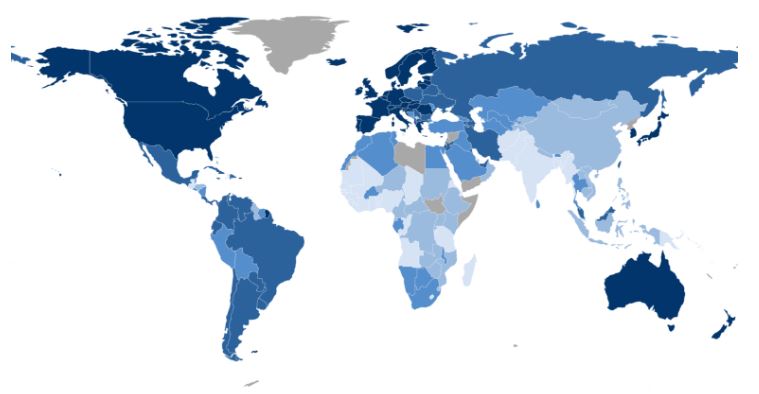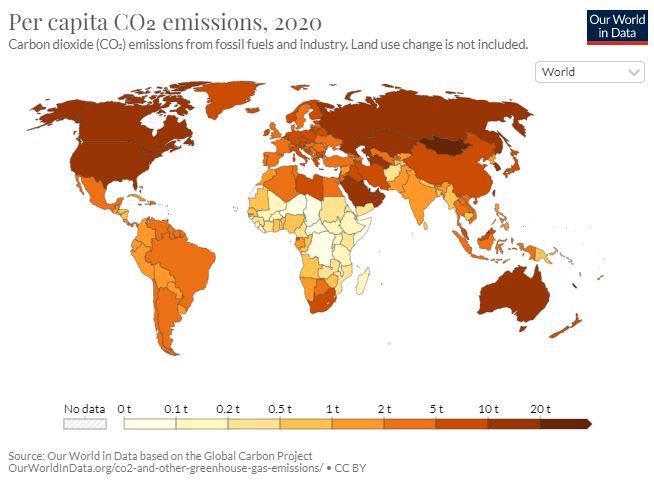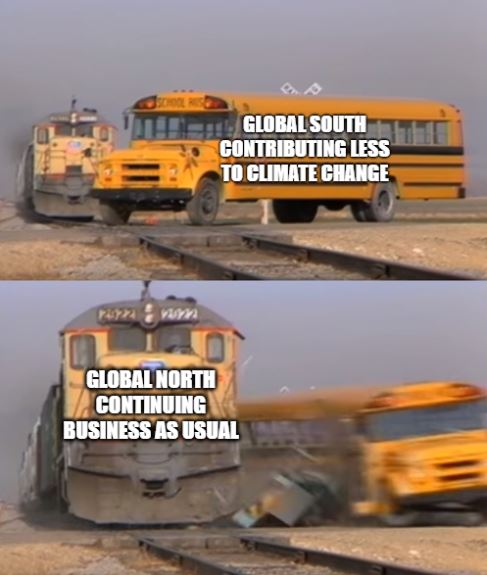A majority of us agree that climate change is a big deal. Last year, a survey by the Associated Press1 found that 59% of Americans said that climate change is an important issue to them, up from 49% in 2018. But a more recent poll2 hints at a specific circumstance that affects people’s perception on the issue: personal consequence. According to the poll, 77% of respondents who have recently experienced extreme weather events see climate change as a crises or major problem, versus only 46% of those who hadn’t experienced such events see climate change similarly. Hence, a big determining factor: does climate change affect me personally or not? The fact of the matter is that the people who are most affected by climate change generally a) have little power to combat its affects and b) are contributing to the problem the least. Seems unfair to me.
Effects of Climate Change
I could probably dedicate hours of research and a whole series of blog posts on all the effects of climate change. It’s a complex problem with many different facets, intertwined with and exacerbating other socioeconomic and political problems. But I’ll just focus on three major areas that affect human life.
the poor and disadvantaged are further disadvantaged by climate change and the extreme weather conditions that come with it
A Polluted Environment
I’m not just talking about litter in the streets. Chemical toxins, carcinogens, and emissions pollute our air and water, both of which affect human health. Polluted air can cause respiratory infection, heart disease, lung cancer, and birth defects, as well as damage to the brain, kidneys, liver, nerves, and other organs due to long-term exposure. Water pollution causes illness, like cholera, diarrhea, and other gastrointestinal disease, or reduces the availability of potable or drinkable water.
Natural Disasters
Natural disasters and extreme weather conditions like heat waves, wildfires, floods, and tropical storms are coming more frequently and are more catastrophic. Researchers suggest that damaging hurricanes in the US are three times more frequent than 100 years ago3. Wildfires in Europe have burned almost three times as much land as the average of the last 15 years4. Globally, weather is more often breaking records, and not in the good way.
Just last month, Hurricanes Fiona and Ian hit Puerto Rico and Florida, both Category 4 storms. The rainfall in Pakistan has caused the worst flooding in recent history, submerging about a third of the country under water. The scientific principle behind these events: warming of the planet increases evaporation which means more water vapor and heat gets drawn in by storms as they cross the ocean. The result is heavier rainfall and stronger winds when they hit land. Additionally, the rise of sea levels (warming causing glaciers to melt) means that storm surges along coastal regions are also more destructive.
The Economy
These natural disasters not only affect human life, but also infrastructure and the economy. It takes money to pay insurance claims and rebuild damaged infrastructure (roads, bridges, dams, factories, power grid, etc). In the U.S. alone, the past year of natural disasters has cost $153 billion, already more than the average cost per year of the last three years ($105 billion)5. When insurance companies are hit, this can lead to detrimental ripple effects in the housing market. Natural resources like forests and farms may be impacted as well, which then affects manufacturing and agricultural yields. These economic effects are also lasting; the longer it takes to recover, the more these economic effects may compound. Any lack of funding or capital makes it increasingly difficult to recover.
Demographics Most Affected by Climate Change
The people who are most affected by climate change are, unfortunately, already the most vulnerable members of society. In the US, polluting factories are typically built in low income areas, mostly inhabited by BIPOC populations. These communities are then more likely to develop health complications with lower access to health care and have no voice against such industrial developments due to governmental redlining and capitalist interest.
Children and the elderly are also more likely to experience the negative health affects of pollution, either due to their underdeveloped or aging immune system, respectively. Those with underlying health conditions are also more susceptible to increased risk from air and water pollution.
Regarding natural disasters, economic inequality also underlines the disparity of climate resilience. Lower income and BIPOC communities receive less aid than their majority white counterparts, as well as less reinvestment to help rebuild. Furthermore, their communities are more vulnerable to natural disasters from the get-go, because of less robust infrastructure and substandard insurance plans, again, at the hands of the government and special interest. Those in the lower classes also tend to rely on assets such as farms, livestock, workshops, and equipment, that could be destroyed by natural disasters. When disaster strikes, they could lose these assets, lose their livelihoods, lose their access to food and income.
Basically, the poor and disadvantaged are further disadvantaged by climate change and the extreme weather conditions that come with it. Evidence shows that poverty rates typically increase after a natural disaster has wreaked havoc.
Geographic Areas Most Affected by Climate Change
Outside of the US, the same theme holds true. The countries with poorer economies and less resources are the ones most affected by climate change. The Yale Center for Environmental Law and Policy6 published the 2020 Environmental Performance Index, which ranks each country on its resiliency and recoverability amidst climate change. The results are shown in the Figure below, with lighter colors representing the lowest resiliency.

Compare this to the CO2 per capita emissions of each country7:

This begs the question, why do the ones contributing the least have to suffer the most?
The Least Affected by Climate Change
As highlighted above, the most vulnerable countries belong to the developing world (Global South), whereas the most resilient countries belong to the developed world (Global North). For centuries, there has been great disparity between the Global North and the Global South. Born of colonial ambition and capitalist growth, the Global North continues to make profit and take advantage of the Global South. In the Global North, manufacturing is mostly sent overseas and so are the pollutants that go with it. The Global North, particularly the United States, sends large amounts of waste to poorer countries who lack the infrastructures to handle such waste. The citizens of the Global North have the luxury of ignoring climate change or kicking the proverbial can down the road, because they don’t have to face its effects every day.

As a resident of the Global North, I’ll admit that I can feel this luxury. I don’t relate to the negative impacts that I listed above. As an environmentalist, I do feel guilt when I act in ways that aren’t ecofriendly, like creating unnecessary waste or increasing my carbon footprint. However, the privilege of my geographic location, social status, and existence in the Global North means that I can ignore that guilt. I could continue to drive a carbon-emitting car. I could still buy clothes and goods produced with fossil fuels. And I could continue producing waste without regard to its final destination. All without directly affecting my quality of life. (I could do all these things, but my sustainability journey pushes me to do less of these things).
In other words, those least affected or completely unaffected by climate change have no great motivation to do better. Unless they want to help those who are affected, which I know is a big ask.
So what will motivate the least affected to do their part?
A couple years ago, I had a lively debate with a friend about the climate “crisis” and what it would take for all of humanity to really acknowledge it as such. His argument was that people have to literally be smacked in the face with immediate consequence before being spurred into action. As an illustration, climate change would need to be on the same level as an alien invasion to be considered a crisis. A tangible, visible enemy to supersede life’s other problems and garner necessity of action. Only then would larger swaths of people and governments mobilize against the common enemy.
Obviously, our conversation was merely a thought experiment. And many climate activists already agree on the severity of the climate crisis and the immediate need for action. But the numbers in the polls suggest that my friend may not have been completely off course in his reasoning. If not the increased frequency and severity of natural disasters, if not the health complications of pollution and ‘dirty’ energy, if not for the suffering of developing and coastal populations, then what? Barring an invasive extraterrestrial to force our hands, what would it take for more people to actively fight?
I know the moral argument rarely wins. Not surprisingly, for those not personally or immediately affected, fighting climate change gets deprioritized or put on the back-burner. Life is already difficult without having to worry about other people’s problems. And honestly, I don’t yet have a compelling counterargument to that sentiment. I just wanted to shed light and impart knowledge in the hopes that it will at the very least, provide food for thought.

References
1Associated Press: https://apnews.com/article/climate-joe-biden-science-environment-and-nature-only-on-ap-1e48e3315d2e0b618ccaa4a8d466e057
2Harvard School of Public Health: https://www.hsph.harvard.edu/news/press-releases/poll-facing-extreme-weather-is-changing-americans-views-about-need-for-climate-change-action/
3Environmental Defense Fund: https://www.edf.org/climate/how-climate-change-makes-hurricanes-more-destructive
4The New York Times: https://www.nytimes.com/2022/09/07/briefing/climate-change-heat-waves-us-europe.html
5National Centers for Environmental Information: https://www.ncei.noaa.gov/access/billions/summary-stats
6Yale Climate Communications: https://climatecommunication.yale.edu/news-events/countries-and-territories-most-affected-by-climate-change-also-more-likely-to-believe-it-to-be-personally-harmful/
7Our World in Data: https://ourworldindata.org/co2-emissions

This excellent website truly has all the information and facts I needed concerning this subject and didn’t know
who to ask.
Here is my site :: best gold ira companies